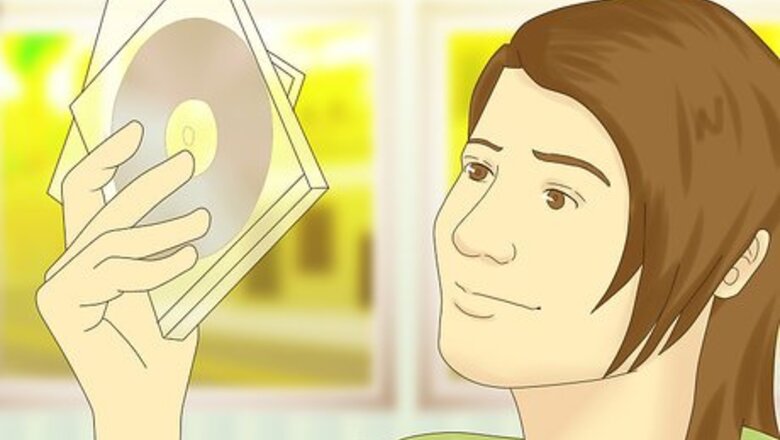
views
Creating and Understanding Your Free Copyright
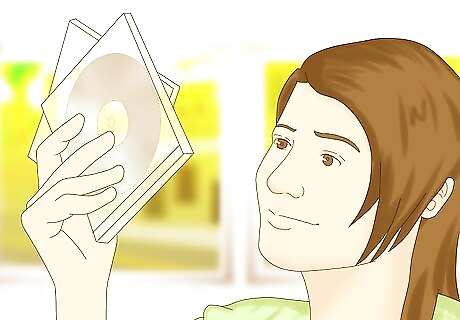
Realize that you have a copyright automatically. By international law, you actually own the copyright to your song (or book, artwork, or other artistic creation) as soon as you create it. Your copyright is free and is automatic. The song must be “fixed” in some way, in a written down copy or a recording. You cannot have a copyright to a tune in your head, or that you perform in public, unless you write it down or record it in some fashion. You do not have to take any action to have this copyright. The actions that people refer to when they talk about “copyrighting a song” are steps to register and protect your copyright, which make it easier to prove that it is yours if some dispute arises.
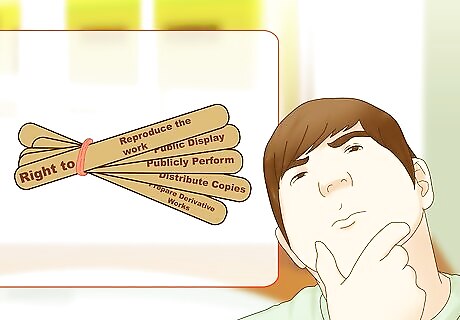
Understand your “bundle of rights.” A copyright is not a single thing. The word “copyright” is actually a single term that applies to several different rights that attach to a piece of music. If you are the original writer, singer, recording artist and record producer, you may own all the copyrights to the song. But if you wrote a song and Taylor Swift recorded her own performance of it, you would have the copyright to the written song, and she would have the copyright to her recorded version of it. There are many other technicalities involved in who owns the copyright of "works made for hire", and things created as joint works. Your exclusive rights are also subject to various statutory limitations, such as "fair use" and certain "educational uses", that are not infringements of your rights.
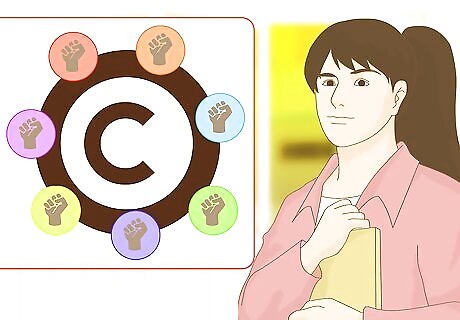
Know the different rights involved with your copyright. Included in your "bundle of rights" are several separate rights or licenses. You can keep part of the copyright to yourself, and license away another part, for example. Some of the different rights, broken into their separate parts, and some of the related licenses, are: Public performing right. If you are the owner of a song, you have the right to control its performance or transmission in public. Public performing license. A license is a permission that can be granted to someone for a specific purpose. A public performing license is a permission that can be granted to someone else to perform your song. If you register your music through a publishing company like BMI, the company will manage public performing licenses for you. Reproduction right. As the owner of the copyright of a song, you control who may reproduce your song in a record, cassette, CD, online or any other format. Mechanical license. A mechanical license is a permission to someone to reproduce and distribute a specific composition at an agreed price. Signing a recording contract will involve a mechanical license. Synchronization license. A synchronization license is permission granted for the use of a song or recording to accompany a visual performance, such as background music for a movie, television show or video. Derivative works. You have the exclusive right to have your work modified in any way to create a new work, to to put it into a different form, including translations of lyrics or change of tempo. You may license such rights to others, whether for a fee or as a courtesy.
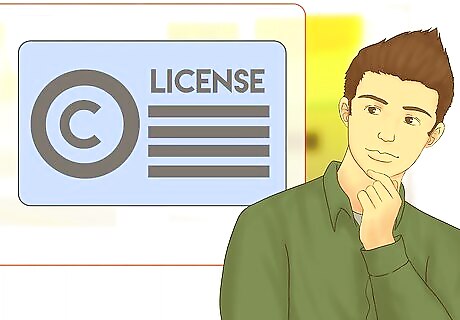
Register with a licensing agency. If you have written a song (lyrics, music, or both), you may register that song, completely for free, with any of several commercial licensing agencies. Registering with these agencies is designed to help you sell licensed use of your song, but it does not provide legal protection for your copyright. Some of the most popular licensing agencies are ASCAP (American Society of Composers, Authors and Publishers), BMI (Broadcast Music, Inc.), or HFA (The Harry Fox Agency, Inc.). They deal with licensing different aspects of your rights. The US Copyright Office also handles issuance of a "compulsory license" for non-dramatic music, after you have published your own recordings. People can apply for that when they want to publish copies of their own recordings of their "cover" performance your work, under 17 USC § 115. You, as the copyright owner, may then receive royalties from the US Copyright Office, or may choose to negotiate a different license with the producers of those recordings. Even if you never register your work with an agency, or in the US Copyright Office, you still have the right to negotiate private licenses that allow others to use your works based upon mutually agreed terms.
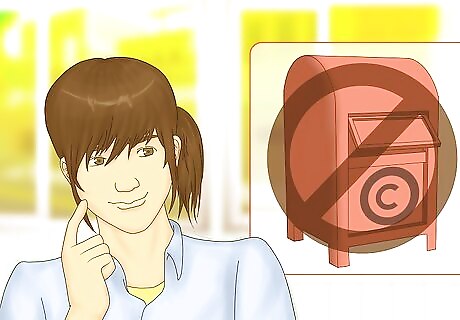
Don't fall for the "Poor Man's Copyright" trick. Some people have described a "poor man's copyright" as a free substitute for registration with the U.S. Copyright Office. This gimmick involves mailing yourself a copy of your song, keeping the sealed envelope, and then supposedly using the postmark as proof of copyright of the contents. You are free to do this, if you wish, but realize that this is no legal protection of your copyright. Some of this confusion may arise from the use of this and similar methods in other countries where registration is not required, or (in most countries) not even possible. Simply having proof of the date of your earlier work is often deemed sufficient proof of your ownership of the copyright.
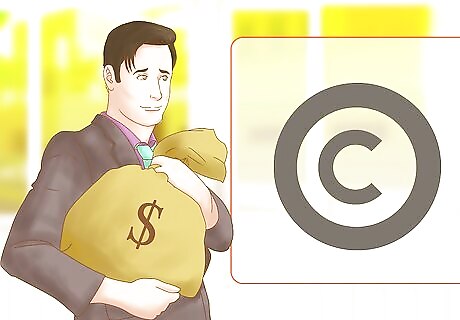
Be willing to pay a bit to protect your copyright. If you've written a song, you own the copyright. Done -- it's automatic, by law. However, to reserve the right to protect that copyright in court means you may need to incur a small fee. You can register your song(s) with the U.S. Copyright Office for $35. This registration is stronger protection of your copyright, because any other writer or performer who comes along later cannot claim a song that is already registered. Also, anyone who wants a license can find your song title and your ownership listed in the US Copyright Office database, once it's registered. Formal registration will be well worth the money if there is ever a dispute later on. Knowing that registration is a condition for enforcement of US copyrights, you might want to check the online copyright database from time to time, in case someone else has decided to register your works as their own, perhaps by mistake. You can search the database by title and author, among other things, free of charge, or hire someone to do it for you. When it comes to unauthorized distribution of your works by online downloads or streams, even your non-registered copyright may be "enforced". Under the provisions of the Digital Millennium Copyright Act (DMCA), you may (as the copyright owner) file a formal complaint with any web hosting service that allows your works to be distributed without your permission. Under DMCA laws (in the USA, similar in other places), they are then required to "promptly remove" the violating publication of your works. Of course, if they refuse, and you want to pursue it, you may need to register your copyright and sue them and their member who uploaded it to their servers. The process to enforce your copyright in a US court can be very expensive and is generally reserved for serious violations that cannot be resolved in any other way. You will nearly always need to have consulted with an attorney before you consider that sort of enforcement. However, in some circumstances, you can also claim restitution of your attorneys' fees, in addition to damages and injunction, when you win your case.
Creating an Online Account with the US Copyright Office
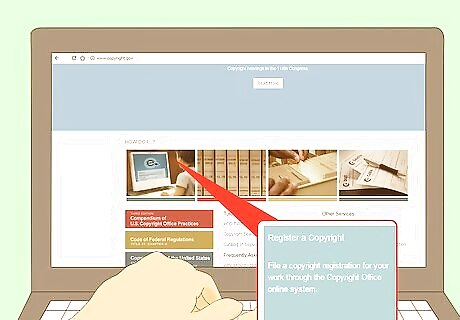
Access the US Copyright Office website. To preregister a song or to register a song online, you must create an account online with the U.S. Copyright Office. Begin by visiting the website at www.Copyright.gov. Select the link to “Register a Copyright” and then select the button to “Log in to eCO.”
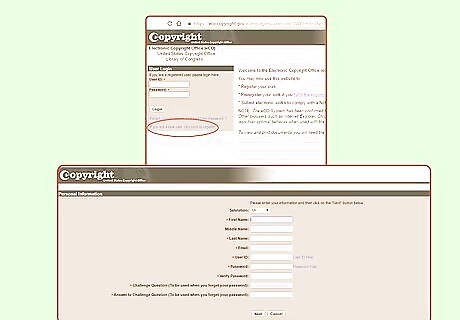
Choose “New User” to create an account. If this is your first time conducting business on this site, you will need to create an account. Choose the button for “New User.” You will then see a screen to create your account. You will need to enter the following information: Name Email address Userid (you will create one) Password (you will create one) Challenge question, as a security tool in case you forget your password Choose “Next” when you are ready to move on.

Provide your address and telephone number. On the next screen, you will be prompted to provide your address and telephone number. After you enter all this information, click on “Next” at the bottom of the screen.
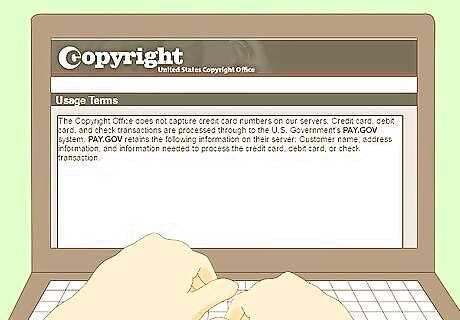
Read the warning notice about credit cards. After you enter all your information to create your online account, you will be shown a notice that the copyright.gov website does not capture any credit card numbers for any payment. When you read this notice, choose “Finish” at the bottom of the screen, and your account will be ready for use.
Preregistering Your Copyright with the US Copyright Office
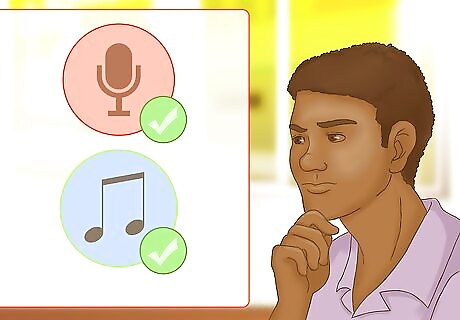
Decide if you qualify for preregistration. Preregistration of a copyright is a step that notifies the U.S. Copyright Office that you have a song or other creative work in process and that is likely to be mass produced in some form. It is not the same as registration and does not have the same legal meaning. For a song to be eligible for pre-registration, the following must apply: For a sound recording, at least some of the sound must already exist in a recorded form, although the final product does not need to be completed yet, and you must verify that you have a “reasonable expectation” that the work will be commercially distributed. For a song composition, at least some of it must be written or recorded in some format, the song is intended for use on a mass produced record or movie soundtrack, and you must have a “reasonable expectation” that the work will be commercially distributed.
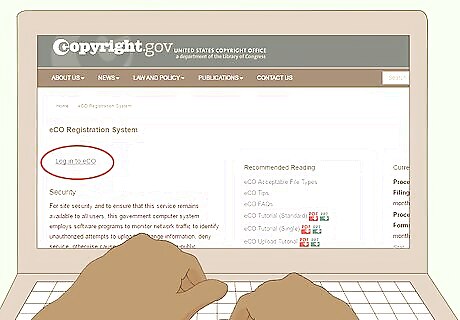
Log in to eCO to preregister online. Preregistration is a step that is only available online through the eCO system. To access the system, begin at the copyright.gov home page, select “Register a Copyright,” and then “Log in to eCO.”
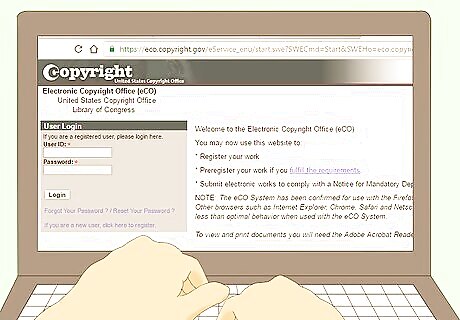
Enter your userid and password. In the box in the top left of the next screen, you will see a place to enter the userid and password that you defined when you created your account. Enter those here and select “Login.”

Select “Preregister a Claim.” On the left side of the next screen, you will see a list of options. In the middle of the list, under the heading of “Copyright Registration,” select “Preregister a Claim.” The screen will change automatically to the next step.

Read the Preregistration Overview. The next screen contains information about the preregistration process. Read through this information to be sure that you wish to preregister, and then continue. Select “Start Preregistration.”
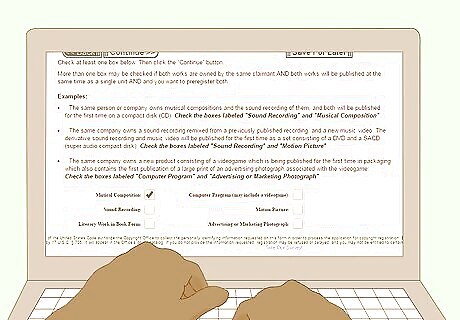
Identify the type of work that you are preregistering. You will have six different choices, and you may select one or more of them. Choose whichever apply to the work that you are preregistering. Make sure that whatever you choose represents the rights that you hold. For example, do not claim the copyright in the sound recording of a song, if you were the writer but not the performer. The choices are: Musical composition Sound recording Literary work in book form Computer program Motion picture Advertising or marketing photograph Move on to the next step by selecting “Continue” at the top of the screen.
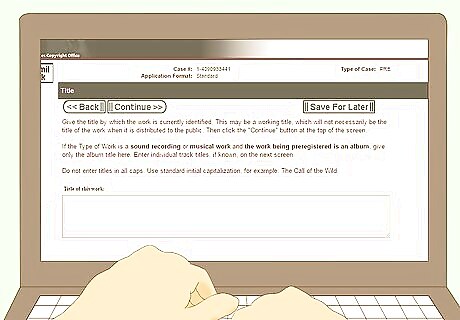
Provide the title of the work. This may be a working title, which could change when the final copy is produced, but you do need to enter a title for the work. If the work that you are preregistering is an album or other collection of songs, you need to give only the album title at this time.
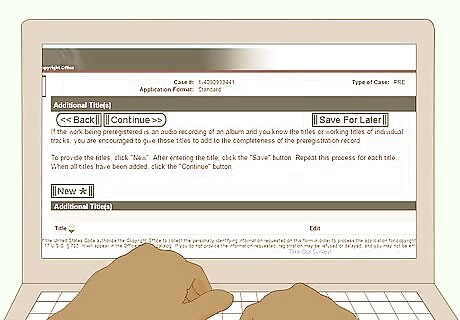
Provide the names of individual songs, if any. The next screen is to list the titles of individual songs. Provide as many as you know, with the current titles. This all may change for the final product.

Provide the name of the author. On the next screen, list the name of the author or authors of the work. If you wish to be known by a pseudonym, then enter that name.
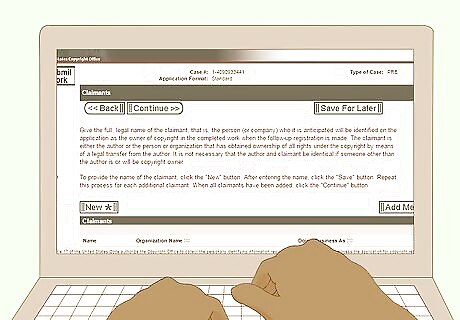
Identify the “claimant” of the copyright. The claimant, in most cases, will be the same as the author. However, sometimes the copyright claimant may be different than the author. For example, if the author is writing a song as a work for hire for a movie, then the movie publisher may be the claimant of the copyright. It is also possible that you have already transferred your copyright ownership to others prior to registration, making the new owners the "claimants". They should have a written, signed and dated copy of the document in which you agreed to transfer your rights.
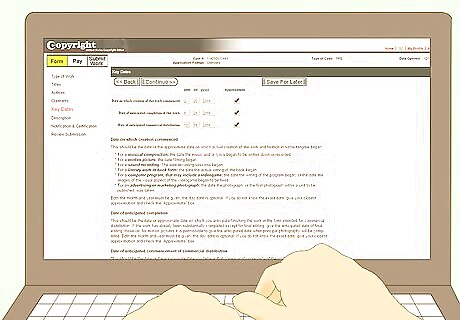
List three important dates related to the composition. The next screen will ask you to identify three important dates to identify your claim in the song: the date you began creating the song the date you anticipate creating the work the date you anticipate commercial distribution
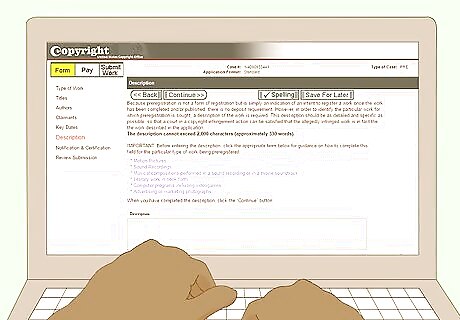
Write a brief description of the song you are preregistering. This description does not need to be very thorough, but enough to be able to identify it in case of a later claim of infringement. Your description is limited to 2000 characters, or about 300 words.
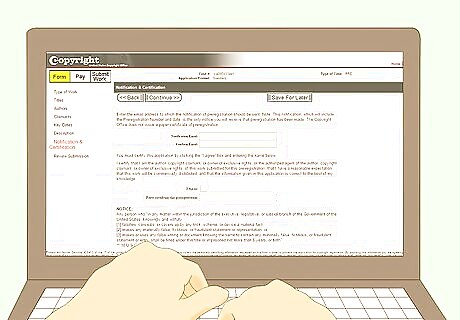
Certify your claim. After you have completed all prior steps for preregistration, you will be asked to certify that you are in fact the copyright holder for the song or album that you described and that you have a reasonable expectation that the work will be commercially distributed in the near future. There is no fee for preregistration. When you certify your claim, you are warned that you are making a statement under oath and that falsifying a claim may be a federal offense.

Register your song after completion. Preregistration is not sufficient to protect your copyright completely. To do that, you must register your copyright within three months after the first publication of the finished work, or within one month if you become aware that someone else has infringed on your copyright.
Registering Your Copyright with the US Copyright Office
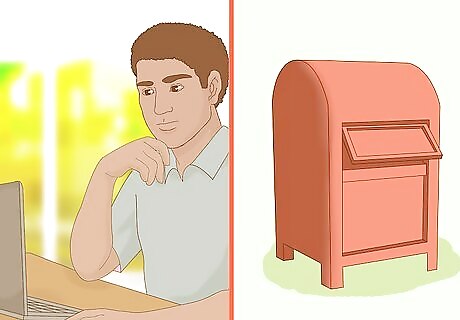
Decide if you wish to register online or by mail. Your registration will be processed more quickly and has a cheaper filing fee if you submit it online. But if you do not have access to the Internet, or if you just prefer to send it by mail, you may do so. The registration is equally valid either way. The instructions in the next few steps (except the login step) will apply equally to online registration or paper registration. To request paper copies of the registration forms, you can call the Copyright Office at (202) 707–3000 or 1 (877) 476–0778 (toll free). You will need to ask for form SR if you are registering a sound recording of a song, or form PA if you are recording the written lyrics or music, without a recording. If you have access to a computer, you can find and print these forms at https://www.copyright.gov/eco/.
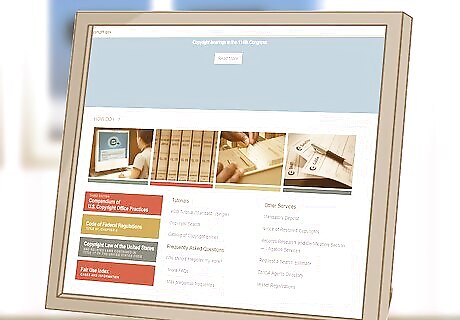
Access the eCO website to begin your registration. To access the registration system online, begin at the copyright.gov home page, select “Register a Copyright,” and then “Log in to eCO.”

Enter your userid and password. In the box in the top left of the next screen, you will see a place to enter the userid and password that you defined when you created your account. Enter those here and select “Login.”
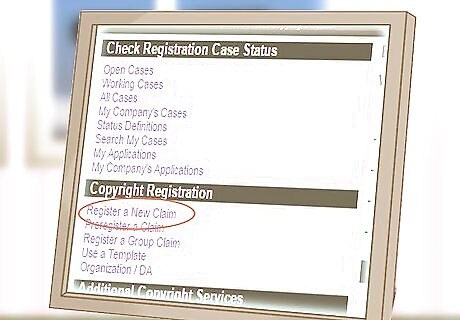
Choose “Register a New Claim.” On the left side of the screen, you will see a list of options. Under the heading of “Copyright Registration,” select the option “Register a New Claim.” You will be directed automatically to the next screen.

Answer three questions to define your registration. The next screen will prompt you with three questions. Your answers to those questions will determine the appropriate application for registering your work. The three questions are: Are you registering one work? If you have a single song to copyright, you will respond “yes.” If you have a collection or a full album, you will respond “no.” Are you the only author an owner of the work? If you wrote the song by yourself, respond “yes.” If you collaborated with one or more other people, say “no.” Does the work contain material by only this one author? If you sampled other music in your song, for instance, you will respond “no.” Otherwise, choose “yes.”
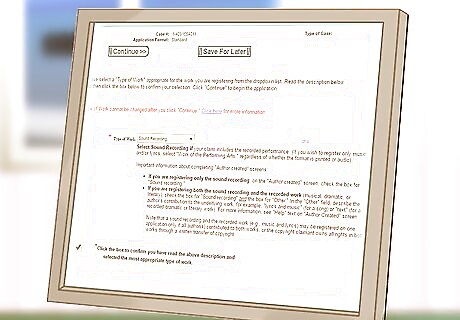
Select the type of work you are registering. There are several choices, to begin the identification of your copyrighted work. Review the list on the dropdown menu, and make your selection. Be careful in making your selection. Once you have chosen the type, you cannot change it. You would have to cancel this entire registration session and start over again. The choices for literary type are: Literary work Work of visual arts Sound recording - this will be your selection if you are copyrighting a particular recorded version of a song Work of the performing arts - this will be your selection if you are copyrighting a written song, but not the actual recording of the song Motion picture/AV work Single serial issue Select “Continue” after you have made your selection.
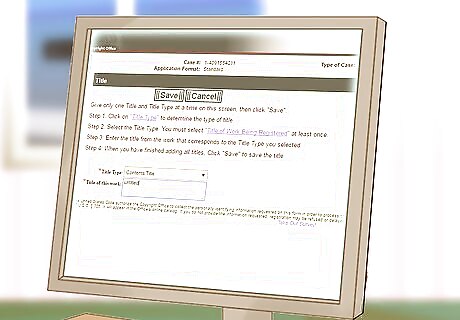
Provide the title of the work. If you only have a working title, provide that. If the work is untitled, then type in “untitled.” On the same screen, you are asked to say whether this piece appears as part of a larger work. This would include a song that is part of an album, or a short story that is part of a collection. Click on “Continue” when you are ready to go on.
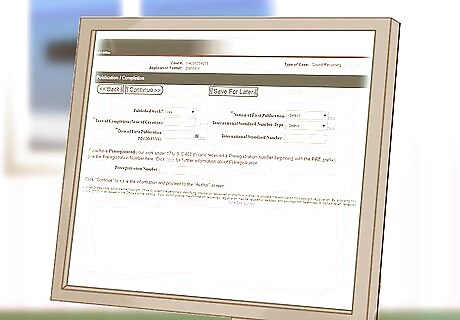
Tell whether the song has been published. For this purpose, publication means offering copies of the song for sale or other public distribution. A public performance of the work does not constitute publication. Respond yes or no to the drop down question. Then you will be prompted to give your preregistration number, if you preregistered this work.
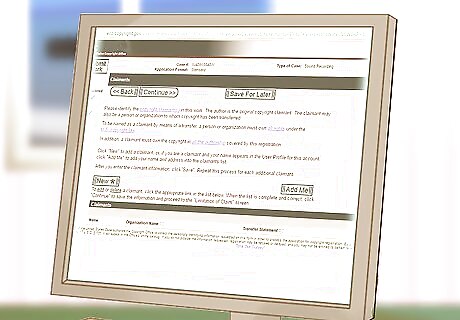
Identify the author and claimant of the copyright. The "legal author" is generally the person who wrote the song, or their employer. The claimant may be the same person as the author, or it may be someone else. For example, if you wrote a song for hire, to be used in a movie, you might (or might not) be the "legal author", and the movie producer may be the claimant. Under US laws, if you're employed for the purpose of creating such works, your employer is considered the author. Similarly, if you are an independent contractor creating a "work for hire", under a properly written contract, the client is considered to be the "legal author" and the owner of the copyright in your work, unless they have signed a different agreement proving otherwise. Unfortunately, resolving the question of "properly written contract" would require the review and advice of an attorney. However, as a bonus, if there is no written contract or the contract for "work for hire" fails for some reason, then you (the author) are the default "legal author" and thus owner of all the rights. Many WFH contracts include a separate "assignment of rights", as a backup plan to own your rights (by written transfer), even if you are deemed the "legal author". Consider the fact that anyone performing on a recording of your performance who is not under a "work for hire" also becomes, by default, a "joint owner" of your copyright in the resulting joint work.
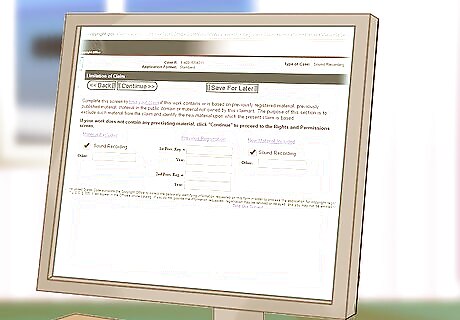
Limit your claim, if appropriate. If your work contains parts of other previously copyrighted works, you will need to identify the original works here. For example, if your song takes samples from other songs, you need to identify those original works. This is a step that may require the assistance of an attorney, if you need help deciding how much use is acceptable as “fair use” or public domain.

Identify contacts for rights and permissions, if you wish. This is an optional step. If you have registered your works with a music clearinghouse, you may wish to identify that organization here for copyright management or permission to use your work.
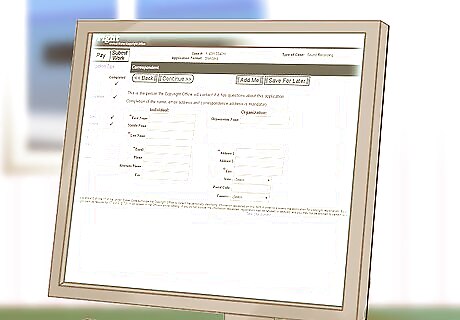
Name a correspondent for further contact. The correspondent is the person who should be contacted by the U.S. Copyright Office if there are any questions about this copyright registration. You may name yourself, or you may choose to appoint a manager or attorney.
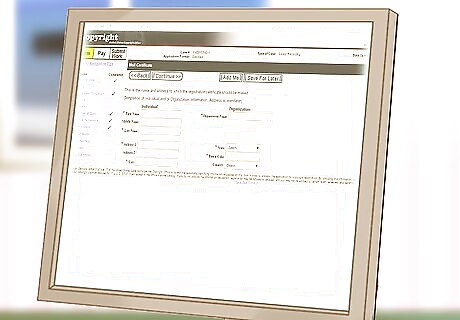
Give your address for mailing the copyright certificate. When your registration has been processed completely, the U.S. Copyright Office will mail you a copyright certificate. You need to give the complete name and address for mailing that certificate.
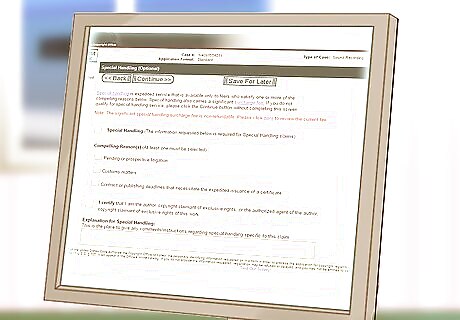
Request special handling, if applicable. If you fall into one of three special categories, you may be able to request special handling of your registration. This will speed the process for your claim to go through the U.S. Copyright Office and to return your copyright certificate. To request special handling, one of the following three conditions must apply: you are involved in pending or prospective litigation there is some customs issue related to the song a contract deadline requires an expedited certificate
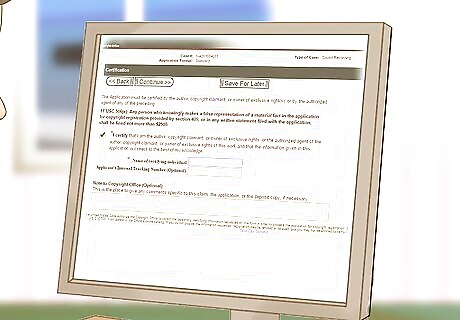
Certify that the claim is yours. The final step is to certify that the copyright of this work is legally yours and that you are legally entitled to claim the copyright. Mark the box and type in the name of the authorized claimant. If you do not complete the certification step, you cannot proceed. You are warned that making a false certification or claim of copyright is a violation of federal law. This is the same law that deters others from falsely registering a claim to your works, giving your registration the weight of evidence you will need in court.
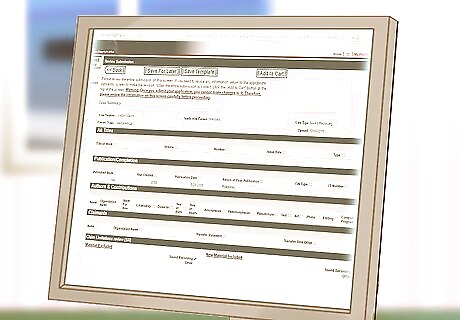
Review your entire submission. If you are submitting your registration online, all the information that you entered in response to the previous screens will appear in one table. Read it carefully and check for accuracy and completeness. If you need to make any changes, you can go back to make corrections. If you are registering on paper, proofread everything carefully. When you have reviewed everything and made any necessary corrections, select “Add to Cart.”
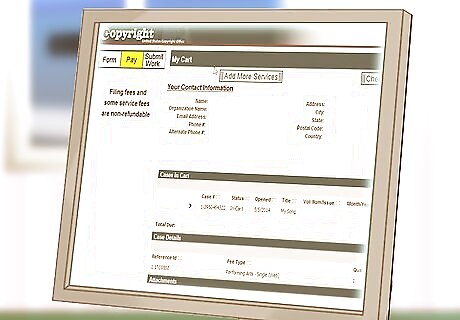
Pay for your registration. After your submission is complete, you need to pay the registration fee. The fee for registering a single new song online by a single author is $35. A standard application for all other filings is $55. You will need a credit card to pay for your registration, or you can open an account through pay.gov. If you are submitting your registration by mail, you need to include a check made payable to “Register of Copyrights" in the amount of $85.
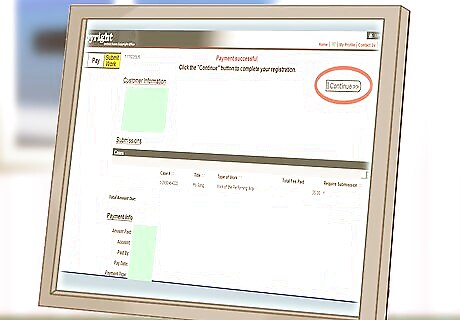
Submit your song. After your payment is complete online, you should see a note that says “Payment Successful.” You now need to follow these steps to upload a copy of your song to accompany the registration: Click the “Continue” button on the upper right of the Payment Successful screen. Click the green “Select files to upload” button in the “Deposit Submission” table. A window with fields for browsing and selecting files to be uploaded should appear. Select the file(s) to be uploaded for the work being registered. As they are selected, the file names will be displayed under the green “Select Files to upload” button. After selecting all files for the work, click the blue “Start Upload” button. When all files have been uploaded for the work, click the green “Complete Your Submission” button. If you submitted multiple applications together, repeat these steps for each application to upload and electronic copy of the work(s). If you are registering by mail, you need to send in a copy of your written music, lyrics, or the recording. You may submit an audio cassette, videocassette, CD or DVD recording. You need to package the recording in a box, not an envelope, in order to ensure proper handling by the U.S. Copyright Office. Floppy disks, zip drives, or other computer recordings are not acceptable. Once you submit the work, your copy will not be returned to you. Many people submit their work by certified mail, but that is not a requirement.
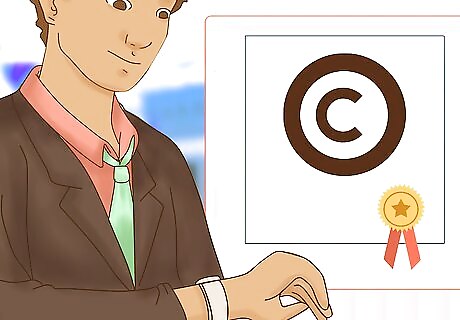
Wait to receive your copyright certificate. After you have completed the registration process, whether online or by mail, your work is over. Your claim will be processed in line with other claims as they are received. Processing time for online filed claims is about eight months. Registrations by mail may be longer. If that much time has passed and you have not received anything yet, you may check the status of your claim by submitting a status request. If the Copyright Office finds problems with your application or the copies you submitted, they will contact you with the problem and give you time to fix it, in most cases.
Protecting Your Copyright Internationally

Understand your automatic copyright protection. As soon as you create a work, you own the copyright to it. This is generally recognized around the world. The procedure of registration with the U.S. Copyright Office protects that copyright within the U.S. The United States has reciprocal agreements with many other countries, whereby each country agrees to recognize and protect copyrights under each other’s laws. Therefore, if you created your work in the U.S., or in other "convention countries", you are protected by copyright laws in those countries.
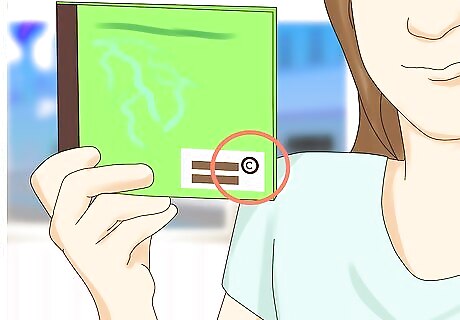
Mark your work with the recognized symbol for copyright. Under the Universal Copyright Convention, an international treaty that the U.S. has been party to since 1955, you can protect your copyright with the internationally recognized copyright symbol: The symbol begins with the letter C with a circle around it Include the date the work was created Include the name of the person claiming the copyright. These marks should appear on the work itself, at the bottom of the page or somewhere on the packaging for a recording.

Review international copyright treaties. The U.S. is a party to several different international treaties regarding the protection of creative works. If you are interested in learning more, you can research these treaties. Some of the treaties that the U.S. recognizes are: the World Intellectual Property Organization (WIPO) the Berne Convention for the Protection of Literary and Artistic Works the WIPO Copyright Treaty the WIPO Performances and Phonograms Treaty the Geneva Convention for the Protection of Producers of Phonograms Against Unauthorized Duplication of Their Phonograms the Brussels Convention Relating to the Distribution of Program-Carrying Signals Transmitted by Satellite.
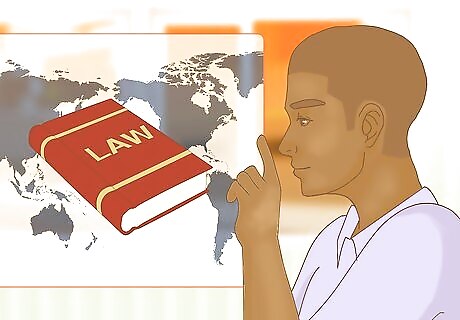
Review the law of a specific country. If you are concerned about protecting your copyright in a particular country, you should research that country’s copyright laws. For this, you may need to enlist the services of an experienced international copyright attorney. As described above, the DMCA only applies in U.S. jurisdictions. However, a number of other countries have established similar guidelines for online service providers (OSP) to avoid copyright liability for acts by its members. Among such countries are Australia, United Kingdom, China, Japan and South Africa. They each have their own limitations. However, absent specific limitations on liability in their country, an OSP could be sued for unauthorized distribution of your copyrighted works.
Recognize the fact that it may not be necessary to strictly enforce all copyright laws against all infringements. You, as the owner, have the choice of whether to take administrative, civil, or even criminal action against infringers, or to simply ignore them. You may grant waivers or even a courtesy (free) license after-the-fact for infringements of which you actually approve. There is an old saying, "Imitation is the sincerest form of flattery." -- Charles Caleb Colton. Do not forget that enforceability of your exclusive rights may also be limited by statute, so do not be quick to attempt legal actions without first understanding the relevant laws.



















Comments
0 comment